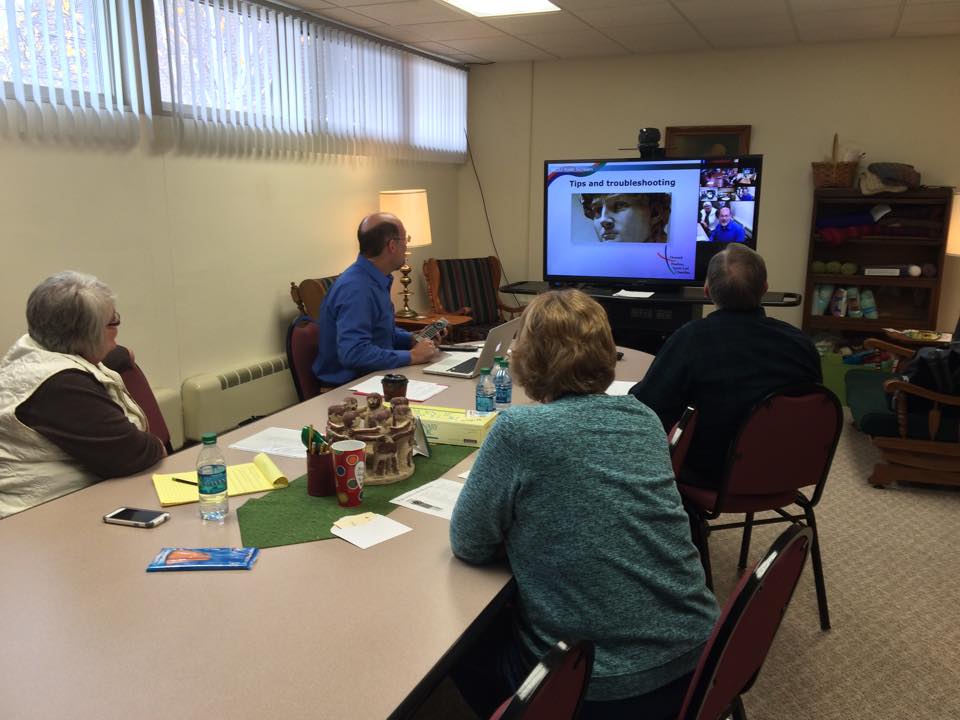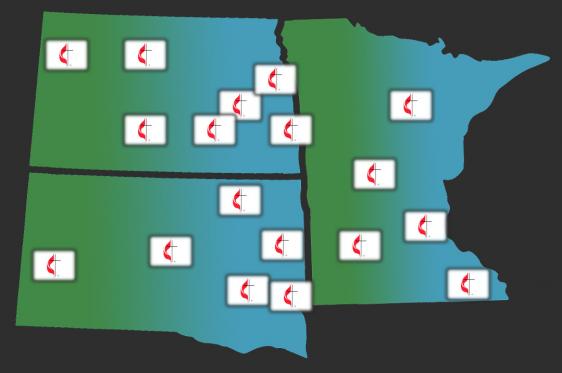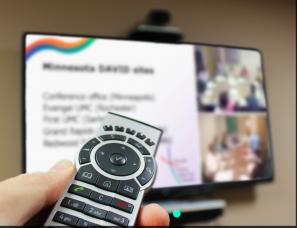
DAVID System is launched in Minnesota
 Five additional sites for video conferencing are ready for use across the Dakotas-Minnesota Area. The sites are video conferencing rooms for small and large groups that allow for two-way video, two-way audio, and use of multi-media. The DAVID Ministry System, (DAK-MIN) allows both the Dakotas and Minnesota Conferences to do small and large group video conferencing, desktop video conferencing, live streaming, and video recording and archiving.
Five additional sites for video conferencing are ready for use across the Dakotas-Minnesota Area. The sites are video conferencing rooms for small and large groups that allow for two-way video, two-way audio, and use of multi-media. The DAVID Ministry System, (DAK-MIN) allows both the Dakotas and Minnesota Conferences to do small and large group video conferencing, desktop video conferencing, live streaming, and video recording and archiving.
Photo: David Stucke, Dakotas Conference Communications Associate, presents "Tips for Troubleshooting" from Redwood Falls, MN. Photo by Christa Meland, Director of Communications, Minnesota UMC.
DAVID was originally named by the Dakotas Conference and is representative of DAKotas VIDeo. The system was recently renamed to DAVID Ministry, DAK-MIN for short, with expansion across the Minnesota Conference.
How it all got started
Video conferencing has been part of the landscape in the Dakotas Conference since 2005. Six small and large group video conferencing rooms were equipped with a camera, microphone, big screen televisions, high speed internet, and a codec. Three of the rooms were located in North Dakota at Bismarck McCabe UMC, Fargo First UMC, and Jamestown First UMC. Three sites were set up in South Dakota at the Conference Office in Mitchell, Rapid City First UMC, and Sioux Falls Asbury UMC.
Conference agencies and committees have utilized the system for countless meetings, information sessions, and trainings. “It has allowed us to meet across the miles, “ said Jeff Pospisil, Dakotas Conference Treasurer.
The North Central Jurisdiction announced in 2010 that the Dakotas and Minnesota Conference would share a bishop beginning September 1, 2012. A transition planning team suggested that video conferencing could assist the leadership of both conferences in doing their work across many miles.
A plan was formed to expand the number of sites and services of the six sites, one function system. A bridging system with component parts was put in place to grow from just room or group video conferencing, to allow for desktop video conferencing, live streaming, and video recording.
The plan also called for five video conferencing or "group rooms" to be set up throughout Minnesota and additional sites to be installed throughout North Dakota and South Dakota.
Additional sites have been installed throughout North Dakota at Grand Forks, Minot, and Williston. Sites were added at Aberdeen, Pierre, and Watertown in South Dakota. In addition, several events including the 2012, 2013, and 2014 Annual Conference Sessions were live-streamed.
Several individuals have utilized desktop video conferencing in the Dakotas Conference. Bishop Bruce R. Ough, resident bishop, has been able to join several meetings simply by using his laptop.
Minnesota launch
Five sites were set up across the Minnesota Conference. All were connected for the first time on Wednesday, October 27, 2014. Rev. Phil Storm, Southern Prairie District Superintendent, led participants in Grand Rapids, Minneapolis, Redwood Falls, Rochester, and Sartell in a dedication liturgy with prayer and song –“We Gather Together”.
Everyone was able to practice using the system. Participants also heard about potential uses of the system, scheduling, and some troubleshooting tip and tricks.
The Minnesota Conference has already utilized the live-streaming feature of the DAK-MIN System during the 2014 Annual Conference Session held in May at St. Cloud. Over 200 viewers tuned into the live-stream at various times throughout the three days.
Cost savings is just one advantage
“We estimate conservatively, that we save about $60,000 annually in travel-related costs by meeting with this technology,” stated Pospisil.
The technology allows people to meet over a distance. Less time is spent travelling to and from meetings. In addition, people who may not have participated in a face-to-face meeting because of the time involved in travel are now willing to get involved.
 Pospisil explained, “A price cannot be put on time saved and involvement of people. I have people who are more willing to participate because of the technology.”
Pospisil explained, “A price cannot be put on time saved and involvement of people. I have people who are more willing to participate because of the technology.”
The system is not flawless. High-speed internet connection is vital. When the Internet is down or interrupted the connection cannot be made. Using the technology does take practice, too. New users often have issues with audio or video because of connection and start-up errors.
Fast forward
The Dakotas Conference is using all aspects of the DAK-MIN system - group or room video conferencing, desktop video conferencing, live-streaming, and video recording and archiving. The system is in use somewhere throughout the Conference 3-4 days of every week.
Minnesota has utilized group or room video conferencing approximately ten times since 2012. Desktop video conferencing is just getting started and live-streaming was launched at the 2014 Annual Conference.
Virtual technologies are exploding. There is a high demand to do business “anywhere, anytime.” Usage and demand will determine what is next for the DAK-MIN System. A natural next step would be to add more rooms, more desktop users, and potentially access on mobile devices.